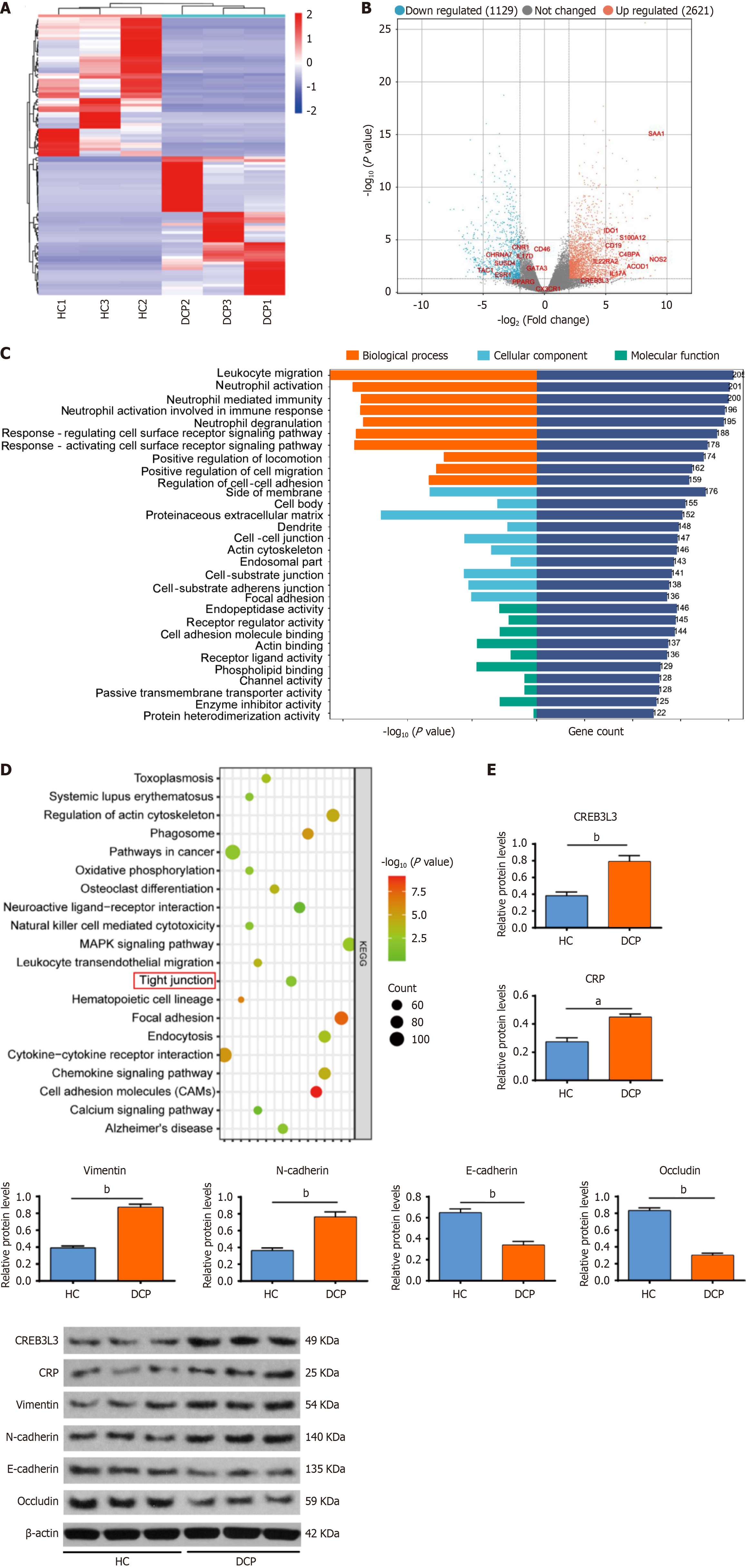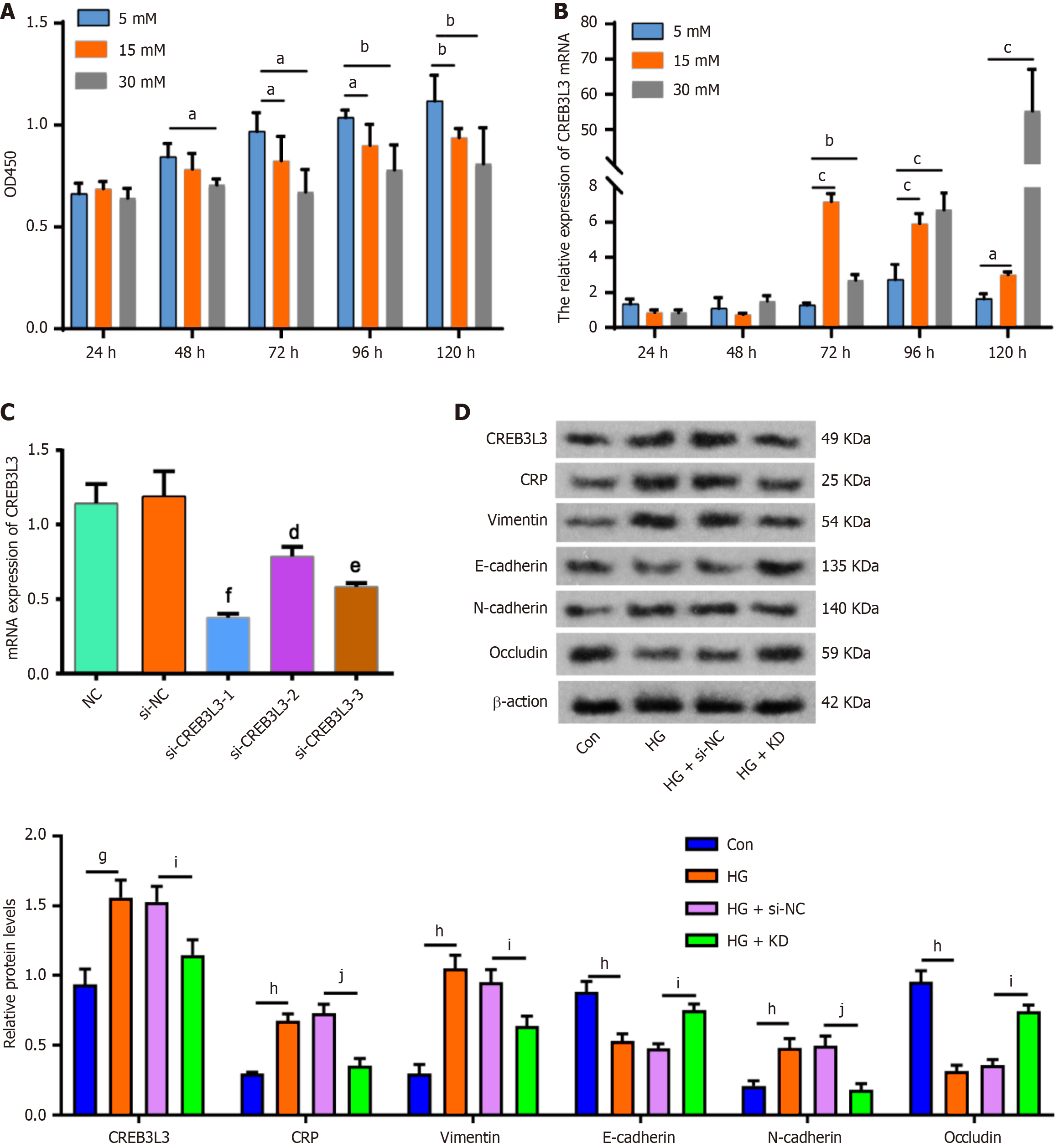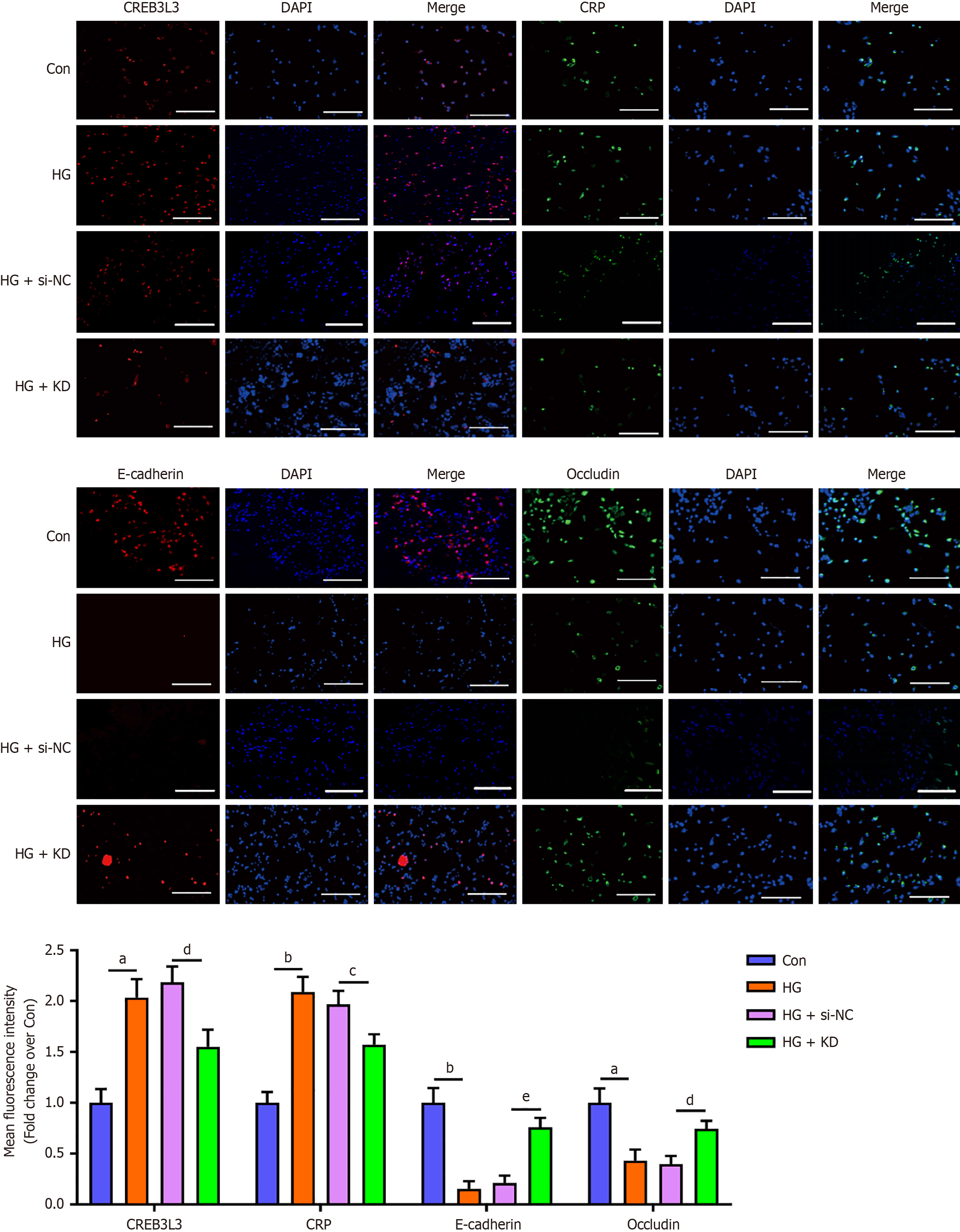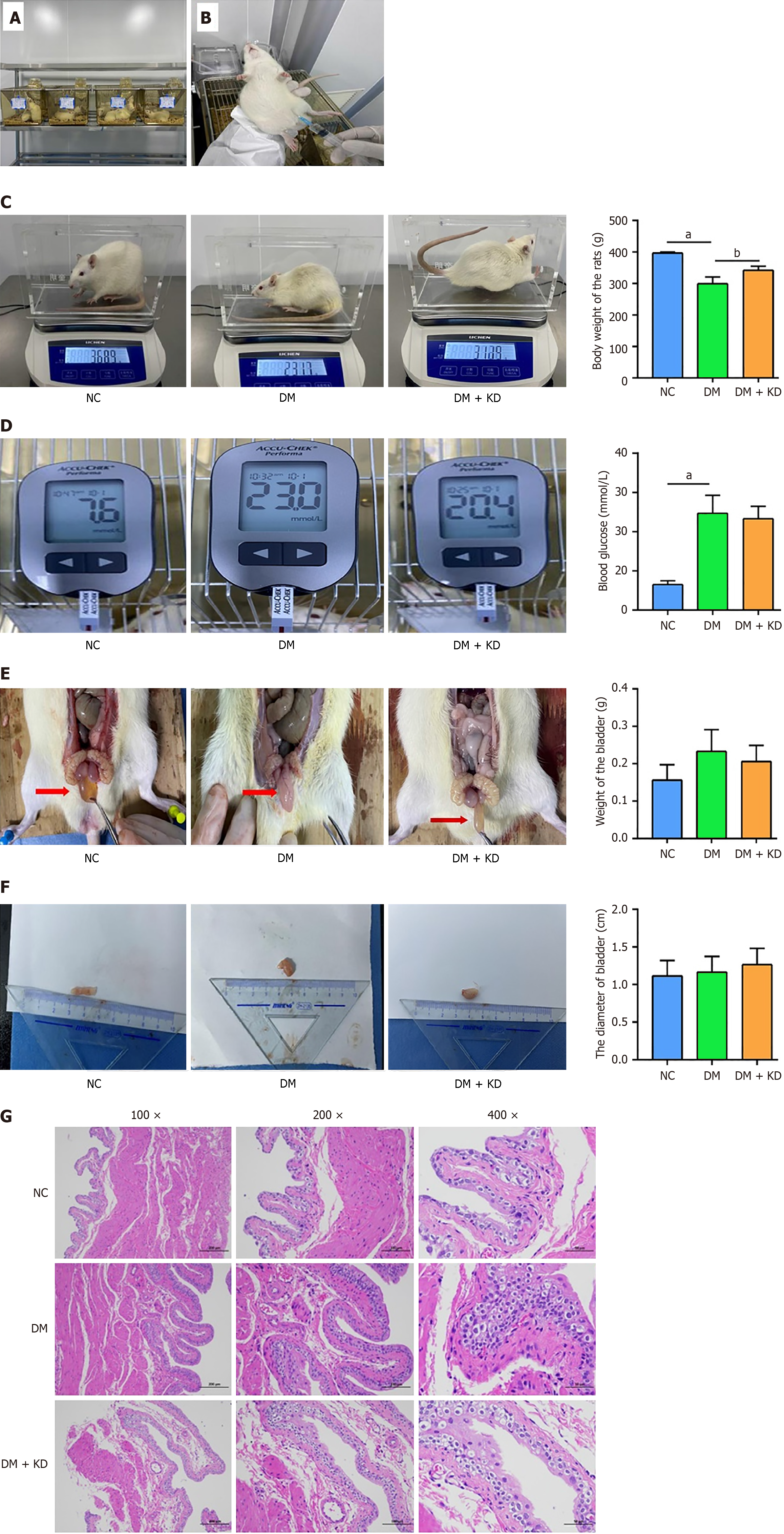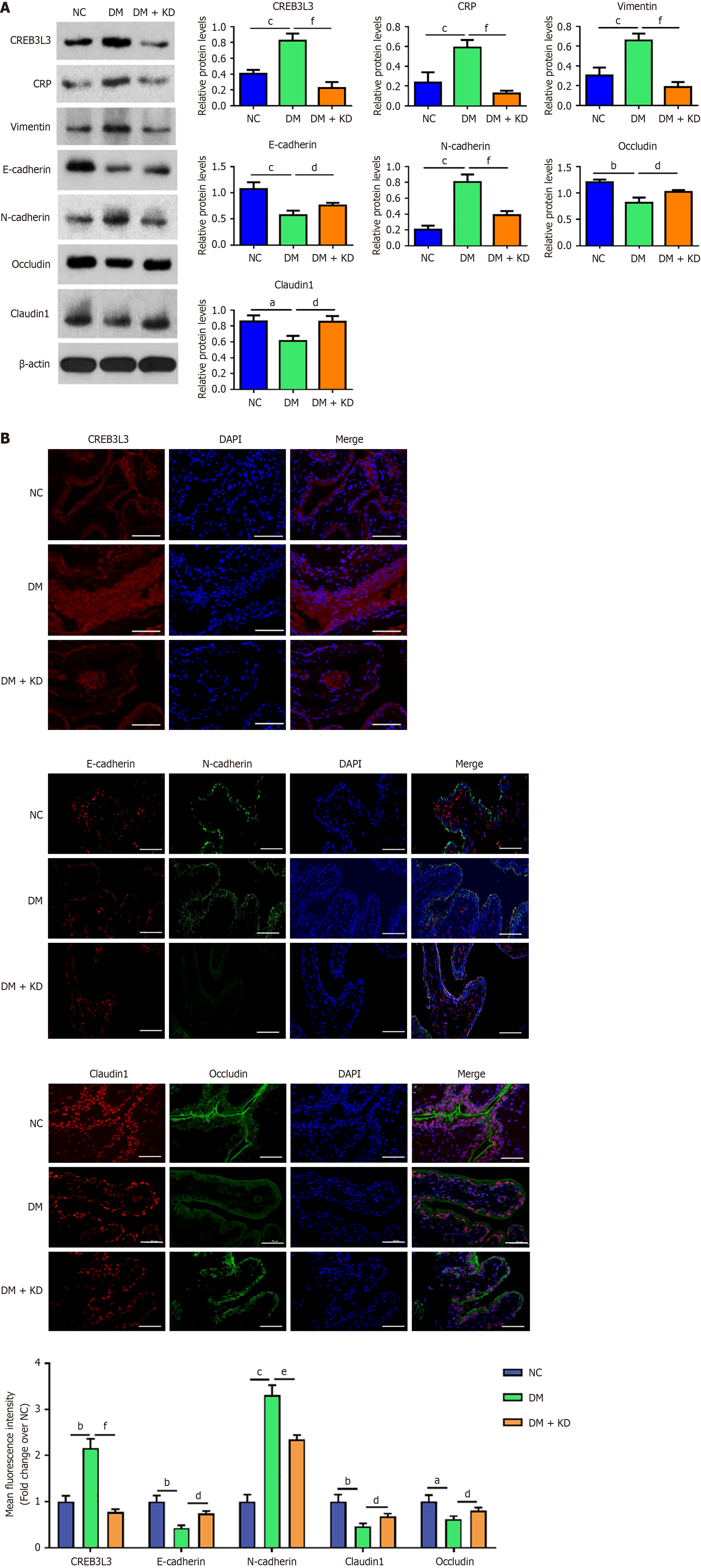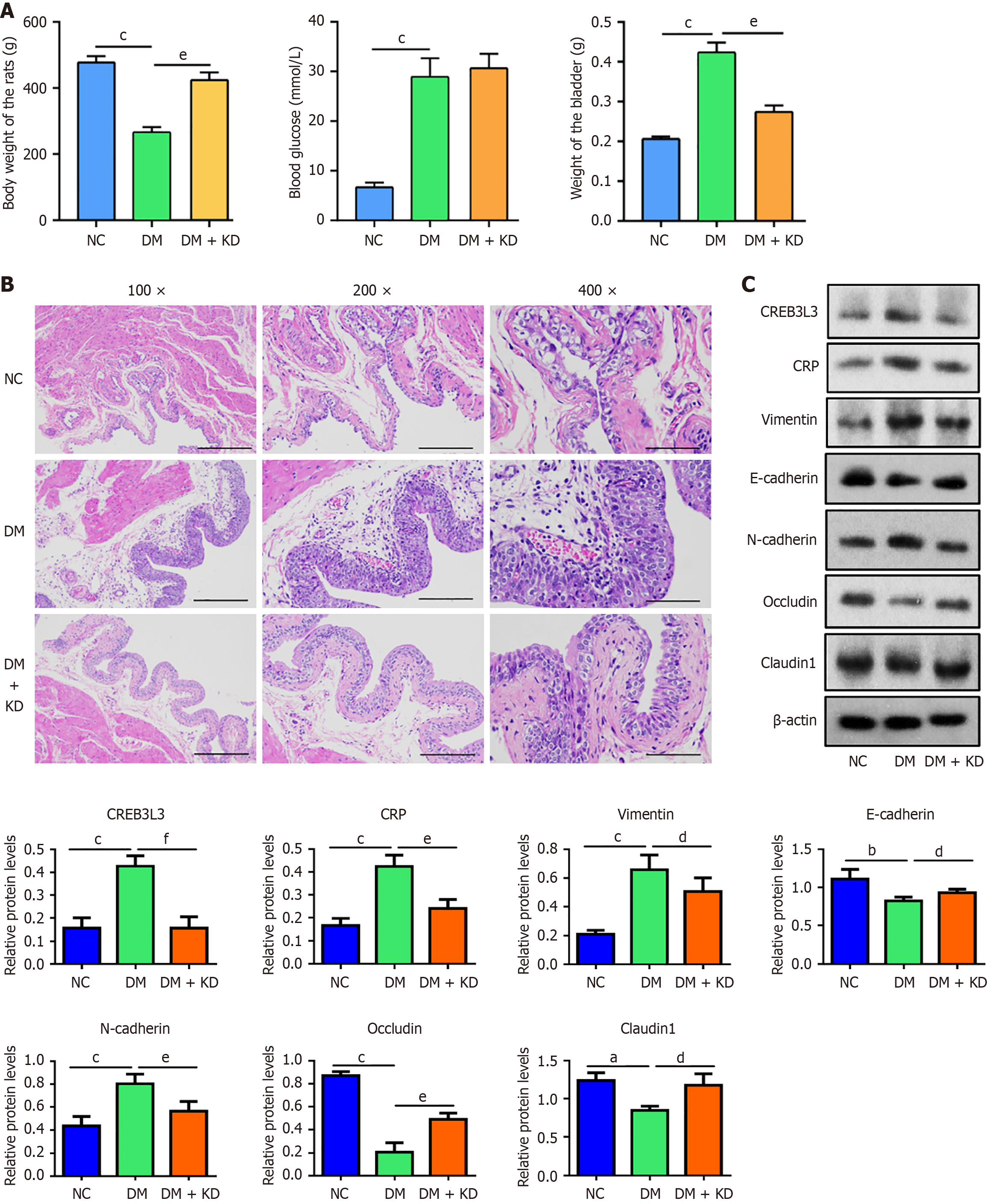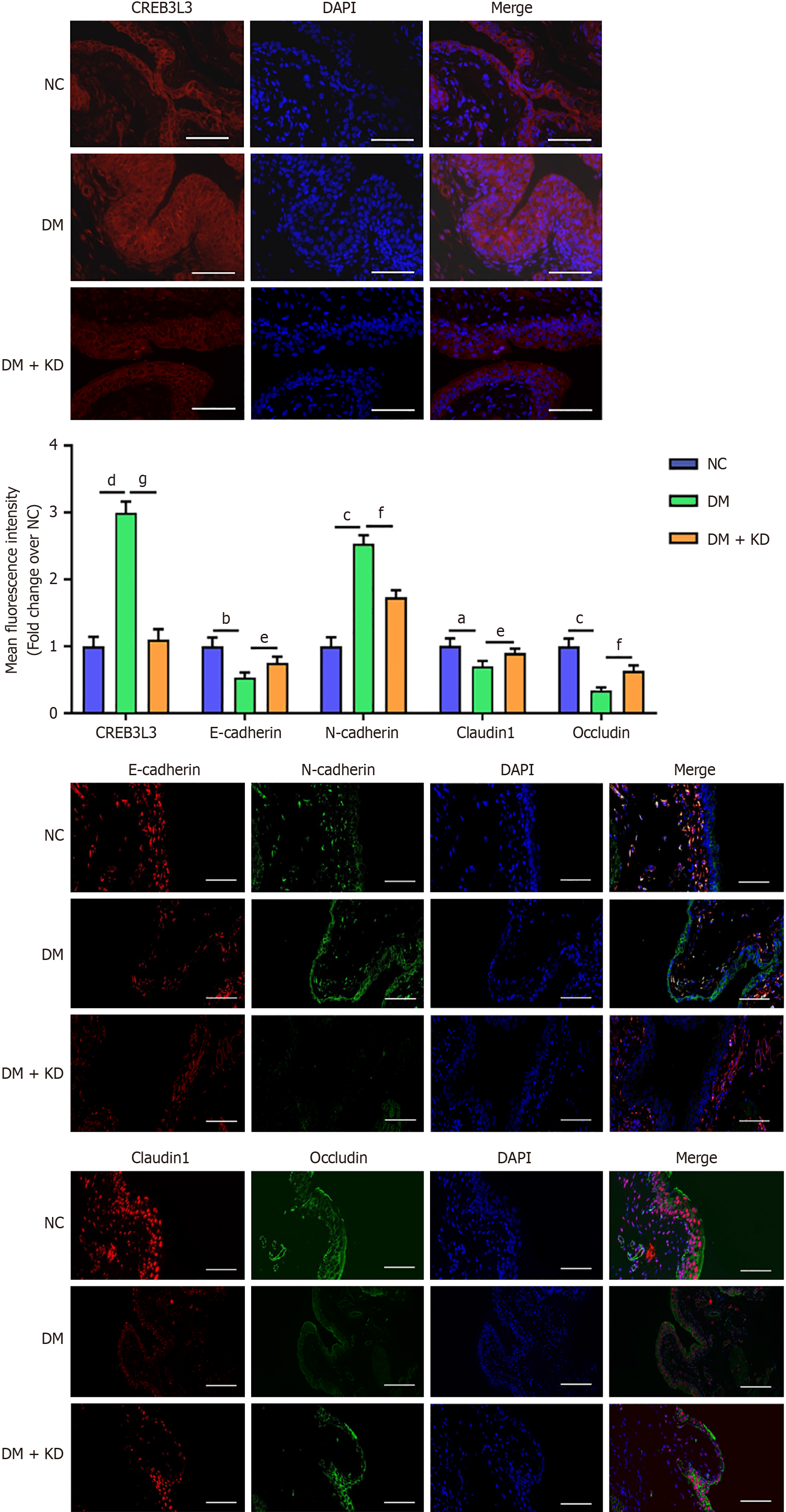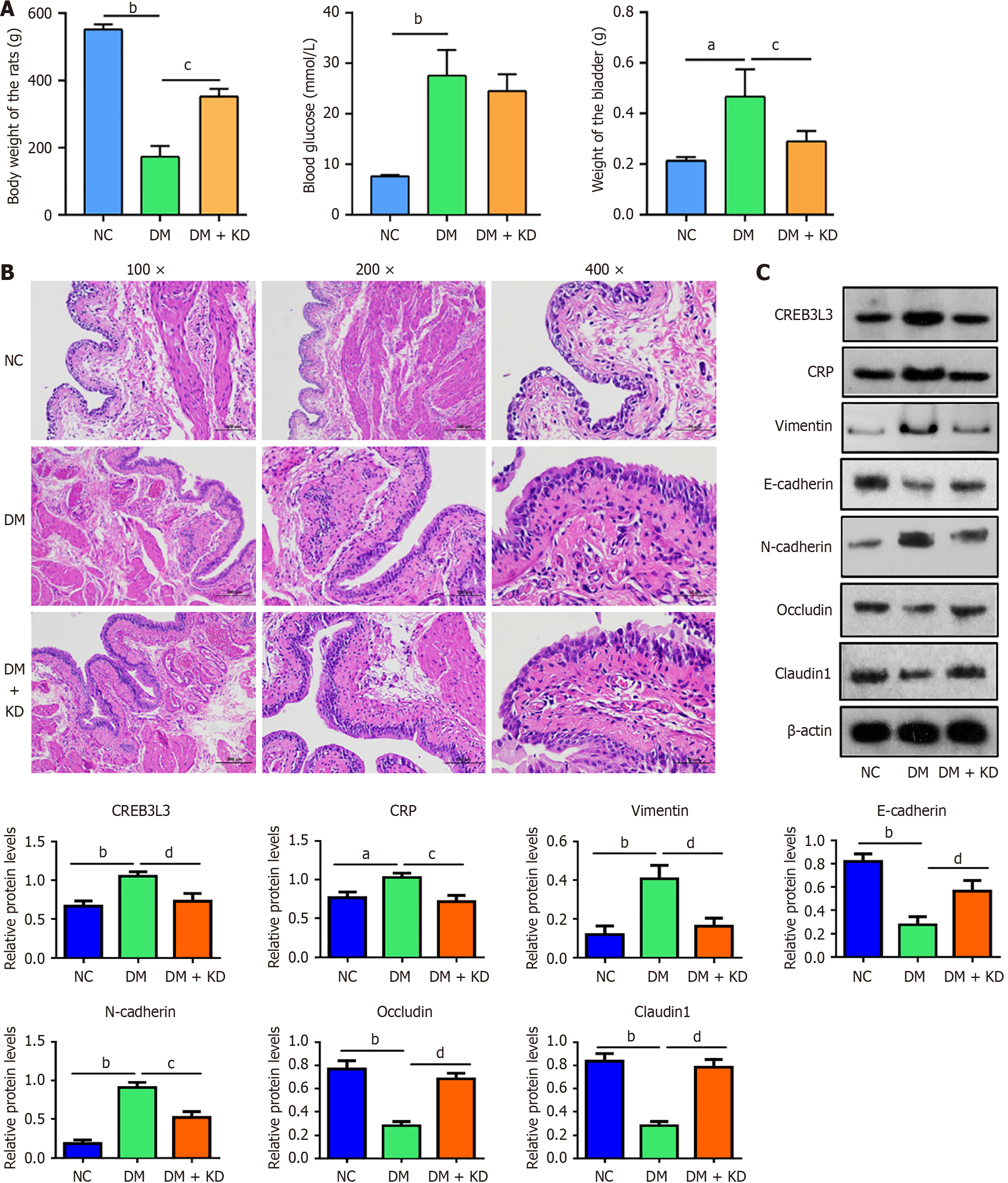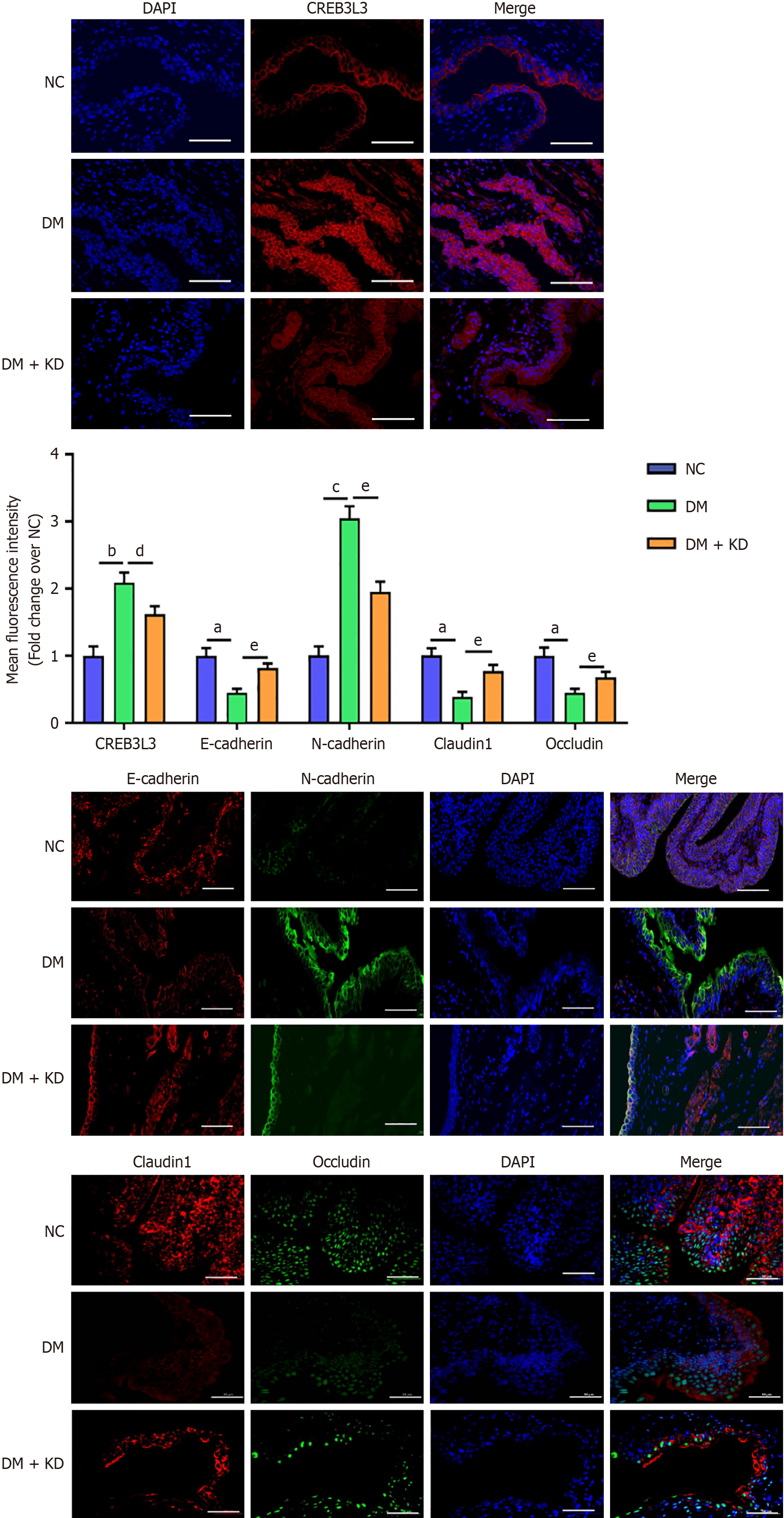Copyright
©The Author(s) 2025.
World J Diabetes. Aug 15, 2025; 16(8): 108101
Published online Aug 15, 2025. doi: 10.4239/wjd.v16.i8.108101
Published online Aug 15, 2025. doi: 10.4239/wjd.v16.i8.108101
Figure 1 Differentially expressed cAMP-responsive element-binding protein 3 Like 3, C-reactive protein, and proteins related to the epithelial-mesenchymal transition and tight junctions in the bladder urothelial tissues of patients with diabetic cystopathy.
Second-generation sequencing was conducted to find genes that are differentially expressed in bladder urothelial tissues between the diabetic cystopathy (DCP) (n = 3) and healthy control (HC) group (n = 3). A: Heatmap of differentially expressed genes (DEGs); B: Volcanic map of DEGs; C: Gene Ontology analysis of the DEGs, including biological process, cellular component, and molecular function; D: Kyoto Encyclopedia of Genes and Genomes analysis of DEGs; E: To identify the results from the second-generation sequencing, we performed western blotting to detect the protein expression of bladder urothelium from the DCP group (n = 6) and HC group (n = 6). aP < 0.01 vs HC group, bP < 0.01 vs HC group. CRP: C-reactive protein.
Figure 2 High glucose induces cAMP-responsive element-binding protein 3 Like 3 expression and the epithelial-mesenchymal transition in SV-HUC-1 cells.
A: Cell Counting Kit-8 assay was employed to assess the viability of SV-HUC-1 cells following treatment with varying concentrations of glucose; B: Relative mRNA expression of cAMP-responsive element-binding protein 3 Like 3 (CREB3 L3) in SV-HUC-1 cells after treating with different levels of glucose, as detected by quantitative PCR; C: Relative mRNA expression of CREB3 L3 in SV-HUC-1 cells with or without silencing of CREB3 L; D: SV-HUC-1 cells were treated with 5 mmol/L and 15 mmol/L glucose for 72 hours with and without CREB3 L3 knockdown (KD). Protein expression of CREB3 L3, C-reactive protein (CRP), vimentin, N-cadherin, E-cadherin, and occludin in SV-HUC-1 cells in the control (Con), high glucose (HG), HG + small interfering RNA negative control (si-NC), and HG + KD group. Each group contained three biological replicates. aP < 0.05 vs 5 mmol/L group, bP < 0.01 vs 5 mmol/L group; cP < 0.001 vs 5 mmol/L group, dP < 0.05 vs si-NC group, eP < 0.01 vs si-NC group, fP < 0.001 vs si-NC group, gP < 0.01 vs Con group, hP < 0.001 vs Con group, iP < 0.01 vs HG + si-NC group, jP < 0.001 vs HG + si-NC group.
Figure 3 Immunofluorescence of cAMP-responsive element-binding protein 3 Like 3, C-reactive protein, E-cadherin, and occludin in urothelial cells under high glucose condition.
SV-HUC-1 cells were treated with 5 mmol/L and 15 mmol/L glucose for 72 hours with and without cAMP-responsive element-binding protein 3 Like 3 (CREB3 L3) knockdown (KD). Immunofluorescence assay was conducted to detect the expression levels of CREB3 L3, C-reactive protein (CRP), E-cadherin, and occludin protein in SV-HUC-1 cells in the control (Con), high glucose (HG), HG + small interfering RNA negative control (si-NC), and HG + KD groups. Scale bar indicates 50 μm, and each group contained three replicates. aP < 0.01 vs Con group, bP < 0.001 vs Con group, cP < 0.05 vs HG + si-NC group, dP < 0.01 vs HG + si-NC group, eP < 0.001 vs HG + si-NC group.
Figure 4 Establishment of diabetic cystopathy models of rats for 4 weeks.
A and B: This study established a diabetic cystopathy model in rats by feeding a high-fat and high-sugar diet and intraperitoneally injecting 1% streptozotocin; C-F: At the end of the 4-week period, the body weight, blood glucose, bladder weight and diameter of the rats were measured, and each group contained five replicates; G: The bladder tissue was retained for hematoxylin and eosin staining, and each group contained three replicates. aP < 0.01 vs negative control (NC) group, bP < 0.05 vs diabetes mellitus (DM) group.
Figure 5 cAMP-responsive element-binding protein 3 Like 3 upregulates C-reactive protein expression, induces the epithelial-mesenchymal transition, and impairs cellular tight junctions in the diabetic cystopathy rat model.
A: Western blot analysis of cAMP-responsive element-binding protein 3 Like 3 (CREB3 L3), C-reactive protein (CRP), vimentin, N-cadherin, E-cadherin, claudin 1, and occludin in the bladder urothelial tissues from each group; B: Immunofluorescence analysis of the expression of CREB3 L3, N-cadherin, E-cadherin, claudin 1, and occludin proteins in the bladder urothelial tissues from each group. Each group contained three biological replicates. Scale bar indicates 50 μm. aP < 0.05 vs negative control (NC) group, bP < 0.01 vs NC group, cP < 0.001 vs NC group; dP < 0.05 vs diabetes mellitus (DM) group, eP < 0.01 vs DM group, fP < 0.001 vs DM group.
Figure 6 Establishment of diabetic cystopathy rat models for 8 weeks.
A: At the end of the 8 weeks, the body weight, blood glucose and bladder weight from rats were measured; B: Hematoxylin and eosin staining of bladder tissues of the rats at the end of the 8 weeks, and each group contained three replicates; C: Western blotting detected the expression of cAMP-responsive element-binding protein 3 Like 3 (CREB3 L3), C-reactive protein (CRP), vimentin, N-cadherin, E-cadherin, claudin 1, and occludin in the bladder urothelial tissues of the rats at the end of 8 weeks. Each group contained three replicates. aP < 0.05 vs negative control (NC) group, bP < 0.01 vs NC group, cP < 0.001 vs NC group; dP < 0.05 vs diabetes mellitus (DM) group, eP < 0.01 vs DM group, fP < 0.001 vs DM group.
Figure 7 cAMP-responsive element-binding protein 3 Like 3 continuously induces the epithelial-mesenchymal transition and impairs cellular tight junctions with the progression of diabetic cystopathy.
At the end of 8 weeks, immunofluorescence staining of cAMP-responsive element-binding protein 3 Like 3 (CREB3 L3), N-cadherin, E-cadherin, claudin 1, and occludin proteins in the bladder urothelial tissues from each group. Each group contained three replicates. Scale bar indicates 50 μm. aP < 0.05 vs negative control (NC) group, bP < 0.01 vs NC group, cP < 0.001 vs NC group, dP < 0.0001 vs NC group; eP < 0.05 vs diabetes mellitus (DM) group, fP < 0.01 vs DM group, gP < 0.001 vs DM group.
Figure 8 Establishment of diabetic cystopathy models of rats for 12 weeks.
A: At the end of the 12 weeks, the body weight, blood glucose and bladder weight from rats were measured; B: Hematoxylin and eosin staining of bladder tissues from rats at the end of the 8 and 12 weeks; C: Western blotting detected the expression of cAMP-responsive element-binding protein 3 Like 3 (CREB3 L3), C-reactive protein (CRP), vimentin, N-cadherin, E-cadherin, claudin 1, and occludin proteins in the bladder urothelial tissues from each group at the end of 12 weeks. Each group contained three replicates. aP < 0.01 vs negative control (NC) group, bP < 0.001 vs NC group; cP < 0.01 vs diabetes mellitus (DM) group, dP < 0.001 vs DM group.
Figure 9 cAMP-responsive element-binding protein 3 Like 3 results in the epithelial-mesenchymal transition and impairs cellular tight junctions in the late stage of diabetic cystopathy.
At the end of 12 weeks, immunofluorescence staining of cAMP-responsive element-binding protein 3 Like 3 (CREB3 L3), N-cadherin, E-cadherin, claudin 1, and occludin proteins in the bladder urothelial tissues from each group. Each group contained three biological replicates. Scale bar indicates 50 μm. aP < 0.01 vs negative control (NC) group, bP < 0.001 vs NC group, cP < 0.0001 vs NC group; dP < 0.05 vs diabetes mellitus (DM) group, eP < 0.01 vs DM group.
- Citation: Wu QG, Zhang MJ, Lan YB, Ma CL, Fu WJ. Hyperglycemia-induced overexpression of CREB3 L3 promotes the epithelial-to-mesenchymal transition in bladder urothelial cells in diabetes mellitus. World J Diabetes 2025; 16(8): 108101
- URL: https://www.wjgnet.com/1948-9358/full/v16/i8/108101.htm
- DOI: https://dx.doi.org/10.4239/wjd.v16.i8.108101









